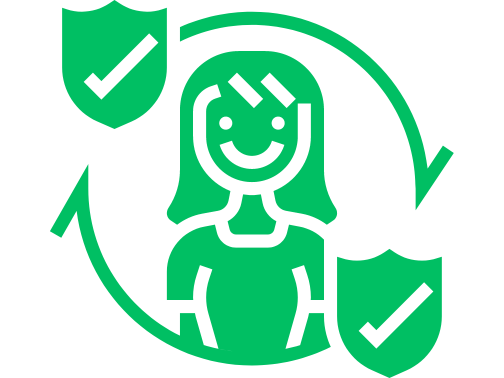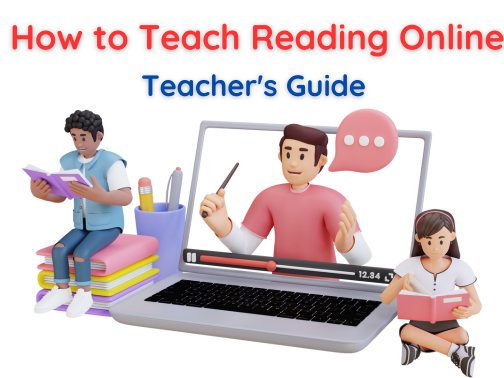Contents
Toggle
Meet David De’ Ath, founder, editor, and writer at Wonderful World English. With his extensive background as an English teacher, David provides valuable insights and practical tips on ESL for students and teachers alike.
We have witnessed a massive change in how learning is done around the world in the form of online teaching.
Students all over the world now spend their time logging on and conducting their studies over the Internet.
Reading is a fundamental aspect of learning and can be effectively taught in an online setting.
Whether a student is learning a foreign language or a subject in their native tongue, there are some practical ways to teach reading online effectively.
It’s important first to choose an online learning platform and reading materials. Teachers should regularly assess their students and provide targeted support based on their needs. Promoting collaboration, establishing clear lines of communication, and offering regular support will also aid in teaching reading online.
I am an experienced English as a Second Language (ESL) teacher who taught countless students online of varying ages and abilities.
I aim to offer some insights into teaching reading online for you today, and we will delve into the importance of this practice and how to do it effectively.
From building comprehension to keeping students motivated and engaged, we will cover this in this guide today.
Computers at the ready, let’s jump in!

How to Teach Reading Online
Teaching reading online offers a plethora of benefits to both teachers and students.
It offers great flexibility and convenience that a classroom setting does not.
Learning from anywhere with a good internet connection has been a game changer for millions of learners, and with continued advancements in technology, we may soon see this as the go-to method for the majority.
Online reading classes can enhance language skills and digital competency and boost learners’ confidence.
It is also an excellent option for those who have limited access to in-class learning for whatever reason.
Let’s look at some practical ways teachers can effectively teach reading online:
1. Setting Up

Before teaching reading online, getting everything prepared and ready is crucial.
Teachers should familiarize themselves with the learning platform and know how to navigate it effectively.
One popular platform I use is ClassIn, which has an excellent user interface and a very good technical support team.
Ensuring you and the students have a stable Wi-Fi connection, the right learning platform and any other required materials is a fundamental first step to teaching reading online effectively.
Clear communication channels need to be established between teachers and their students/parents.
This way, if there are any technical issues or problems in class, they can be promptly remedied.
This ensures structure and allows classes to flow, which is very beneficial when teaching reading online.
2. Choosing Materials

After setting up, it’s time to choose appropriate online reading materials.
This will be based on various factors such as the age and ability of the students, etc.
The materials should align with the student’s interests and not be too difficult or easy.
There are plenty of great places where reading materials can be found, such as online libraries like Google Books.
There are also some great apps that allow you to take your own images and compile them into a file that you can use.
CamScanner can be used, for example, and the images can be put into a Powerpoint for anyone who prefers getting a bit more hands-on.
Once the reading material is uploaded to the online learning platform, it is a good idea to look for accompanying materials.
These can be in the form of images or videos related to the text that can be referred to throughout the class.
This will help keep students engaged and build comprehension, which will significantly aid their progress and hopefully even instill in them a love of reading!
3. Structuring Lessons

Once the materials have been selected and uploaded, it’s important to think about how the lesson will be structured.
Maintaining a proper balance between explaining and promoting student engagement is crucial.
A typical online reading session will begin with an introduction.
Greet each student individually and ask how they are.
Once everyone has been greeted, be sure to explain your class rules.
Clearly state the aims of the lesson and introduce the reading material.
Ask questions and see how much knowledge the students already possess; be sure to keep it relevant to the material.
Break lessons into manageable chunks and incorporate a variety of activities such as shared reading, individual reading, Q&A sessions, and group discussions.
Be mindful of the pace of the lessons and give time for students to properly absorb the content and build their reading confidence and ability.
In future lessons, make sure to review and refer back to prior lessons to ensure students have comprehended and remembered the material.
Related: Read Big Words in English: Teacher’s Tips
4. Interactive Activities

Keeping classes engaging by allowing students to interact is important in building motivation and focus.
Including activities such as songs and games can be a great way to keep classes enjoyable for everyone.
If the students have a high enough ability, be sure to have discussions and even give them projects related to the content.
Most online learning software offers toolkits that can be great additions to your reading class.
These include interactive boards, pens, dice, and other great tools that can enhance the learning experience.
5. Building Comprehension

The whole purpose of online reading is to improve the reading skills and comprehension of the students.
This can be done by encouraging students with certain strategies, such as predicting what they think will happen next, asking questions about the story, and allowing them to summarize their thoughts about the material.
Help them identify the main themes and plots within the material and draw insights from the text.
If it is a picture book, be sure to make the most of the pictures.
If there are not many images, you can include your own pictures or videos to help build comprehension as well.
Whether reading online or in the classroom, check out the guide below for some great tips on how to improve a child’s reading!
Related Article: How to Improve Reading Skills of a Child – Full Guide
6. Assessing and Providing Feedback

Every class will have students of varying abilities and confidence.
It’s important to identify each student’s individual set of strengths and weaknesses and to provide targeted support accordingly.
Some students will require more focus and attention than others, and it’s important to consider this.
Providing consistent feedback to the students or their parents about their progress and performance within the class is necessary for helping students progress.
Make sure the feedback is constructive and consistent and acknowledges the positive aspects of the student’s performance.
Offering suggestions to help the students’ reading, such as through independent practice, will also help them on their reading journey.
Students should be regularly assessed so teachers can track their growth.
Simply listening to them reading aloud is a great way to assess a student.
Also, giving quizzes and letting students provide a written analysis of the reading material can help us see how they are doing and know what feedback to give.
7. Promoting Collaboration

Building an inclusive environment is important to teach reading online successfully.
This means building a sense of community and offering support to every student.
Allowing students to collaborate together and communicate with each other through discussion boards will help keep them motivated and engaged.
Having a place where students can share their thoughts, provide recommendations, and ask questions will greatly contribute to their development.
Collaborating with parents is also very important for helping students develop their reading ability.
Allowing parents to be more active in their child’s learning can be a great way to ensure the students review and practice in their own time.
8. Staying Up-To-Date

As a teacher, it’s a great idea to stay up-to-date with the latest trends and methods to help optimize teaching reading online.
A wealth of great resources are available in the form of workshops, webinars, and online courses that can help teachers improve their craft.
Reaching out to fellow teachers for advice and support is also a great way to help expand your repertoire and become a better all-around teacher.
LinkedIn is a great platform to network with other professionals if you’re looking for a place to start.
As noted throughout this guide, online learning has grown in popularity for many around the world.
But is it the most effective form of learning?
Click the link below to find out!
Related Article: Is Online Learning as Good as Face-to-Face Learning?

Conclusion
Teaching reading online is growing in popularity around the world due to its convenience and ease of access.
Teachers can apply useful strategies to teach reading online effectively to ensure their lessons are conducted effectively.
Choosing the right online platform and materials is crucial before considering the class structure.
Teachers should take it upon themselves to assess their students’ abilities and cater to their individual needs.
Students can be given engaging and effective online reading experiences by implementing the strategies discussed in this guide.
Remember to provide ample feedback and establish clear lines of communication between students and parents.
Reaching out to fellow teachers for advice and insights can also aid anyone on their own teaching journey.
We hope this guide has helped you better understand how to teach reading online.
Have a wonderful day!
Image Attribution: All images licensed via canva.com





